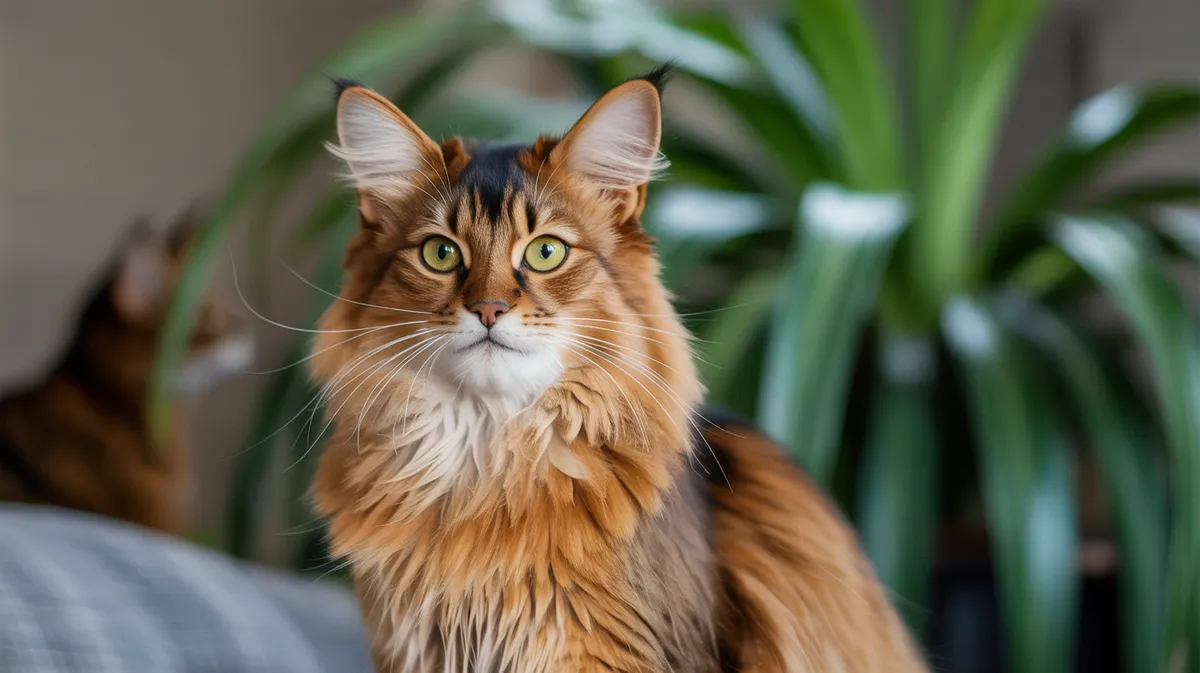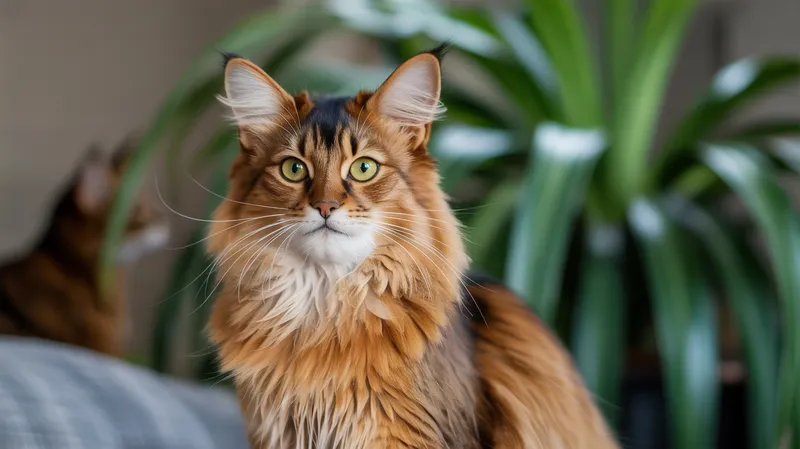
Somali Cat
Felis catus

Meet the Somali Cat
The Somali cat is a long-haired breed of domestic cat, often described as the long-haired variety of the Abyssinian. It is known for its fox-like appearance, with a bushy tail, large ears, almond-shaped eyes, and a soft, ticked coat that comes in various colors. Somali cats are highly energetic, playful, and intelligent, often enjoying interactive games and companionship. Their affectionate and curious nature makes them popular pets for families and individuals alike. Despite their luxurious coats, they are relatively easy to groom compared to other long-haired breeds.
Classification
Mammal
Habitat
Domestic
Diet
Carnivore
Lifespan
12-16 years
Conservation
Not Evaluated
Weight
3.5-5.5 kg
📖Fascinating Facts
Fox-like Appearance
The Somali cat's bushy tail and vibrant coat often earn it the nickname 'fox cat.'
Unique Coat Pattern
Somalis have a ticked agouti coat, where each hair has multiple color bands, giving them a shimmering appearance.
Water Lovers
Unlike many cats, Somali cats are fascinated by water and often enjoy playing with running taps or fountains.
📋Detailed Description
The Somali cat (Felis catus) is a medium-sized, long-haired domestic breed distinguished by its striking resemblance to a small wild fox. Adults typically weigh between 3.5 and 5.5 kilograms, with males generally larger than females. Its most notable anatomical features include a soft, dense, and ticked coat—each hair shaft displays bands of color, giving the coat a vibrant, shimmering appearance. The tail is especially bushy, contributing to its fox-like silhouette, while the large, tufted ears and almond-shaped, expressive eyes (usually gold or green) enhance its alert, inquisitive look. Somali cats possess a muscular yet lithe body, built for agility and active play. Their paws are small and oval, with tufts of fur between the toes, aiding in silent movement. Behaviorally, they are highly intelligent, curious, and sociable, often forming strong bonds with human companions and other pets. They are known for their high energy levels, requiring significant mental and physical stimulation. Socially, Somali cats are interactive, often engaging in group play and displaying a pronounced tendency for vocalization and communication. Reproductively, they are seasonally polyestrous, with litters averaging three to six kittens. Unique adaptations include their ticked coat, which provides camouflage in the wild ancestry, and their keen problem-solving abilities, which are a hallmark of the breed.
💡 Did you know?
The Somali cat breed originated from a genetic mutation in Abyssinian cats, resulting in a long-haired version.
🔬Research & Sources
🎭Behavior & Social Structure
Somali cats are renowned for their playful, energetic, and inquisitive behavior. They exhibit strong predatory instincts, often engaging in stalking, pouncing, and chasing games that mimic hunting behavior. Their intelligence is manifested in their ability to learn tricks, solve puzzles, and manipulate objects to access food or toys. Socially, Somali cats are affectionate and thrive on interaction, both with humans and other animals; they are less likely to be solitary compared to some other breeds. They often follow their owners from room to room, participate in household activities, and vocalize to communicate needs or desires. Daily routines typically involve periods of intense activity interspersed with rest, and they are crepuscular, showing peak activity at dawn and dusk. Their feeding behavior reflects their carnivorous ancestry, preferring multiple small meals and showing interest in high-protein diets.
👶Reproduction & Life Cycle
Somali cats reach sexual maturity between 6 and 10 months of age. They are seasonally polyestrous, with breeding more common in spring and summer in temperate climates. Courtship involves vocalizations, scent marking, and increased affectionate behavior. The gestation period lasts approximately 63 to 65 days. Litters typically consist of three to six kittens, though larger or smaller litters are possible. Queens exhibit strong maternal instincts, providing intensive care, grooming, and protection for their young. Kittens are born blind and helpless, opening their eyes at about 7 to 10 days and beginning to explore their environment by three weeks. Weaning occurs at around 8 to 10 weeks, after which kittens gradually transition to solid food. Somali cats are generally attentive parents, and breeders often report high kitten survival rates.
🛡️Adaptations & Survival
The Somali cat's ticked coat is a direct adaptation from its Abyssinian ancestry, providing camouflage in natural environments by breaking up the outline of the body. The long, bushy tail aids in balance during agile movements and jumps. Their large, upright ears enhance auditory acuity, allowing them to detect subtle sounds, while the almond-shaped eyes provide a wide field of vision. Behaviorally, their intelligence and curiosity are evolutionary traits that would have aided in problem-solving and environmental exploration in ancestral settings. The breed's high energy and agility are adaptations for a predatory lifestyle, enabling effective hunting and escape from threats. Their sociability and strong bonding behaviors are likely a result of selective breeding for companionability.
📚Research Sources
🎨Cultural Significance
The Somali cat, while not associated with ancient mythology like some breeds, has gained cultural significance as a symbol of elegance and playfulness in modern cat fancier communities. Its fox-like appearance has led to nicknames such as 'fox cat' or 'long-haired Abyssinian.' The breed is celebrated in cat shows worldwide and is a favorite among cat enthusiasts for its beauty and engaging personality. Somali cats have also been featured in media and advertising, often representing the ideal of an active, intelligent companion animal. There are no known traditional uses or mythological associations beyond its modern role as a beloved pet.
🔬Recent Research & Discoveries
Recent genetic studies have confirmed the Somali cat as a long-haired variant of the Abyssinian, with the longhair trait resulting from a recessive gene (Fgf5 mutation). Ongoing research focuses on breed-specific health issues, particularly hereditary diseases such as pyruvate kinase deficiency and progressive retinal atrophy. Advances in feline genomics have enabled more precise screening for these conditions, improving breeding outcomes. Behavioral studies highlight the Somali's advanced problem-solving abilities and social intelligence, making them a model for research on feline cognition and human-animal interaction. There is also interest in the breed's unique coat coloration genetics, contributing to broader understanding of feline pigmentation.
🎥Wildlife Videos

🐾 The Elusive Serval: Africa's Lesser-Known Spotted Cat 🐆 | Wildlife Conservation
Watch the mesmerizing world of the seldom-seen Serval, one of Africa's lesser-known and agile spotted cats, as we embark on a ...
Lion Mountain TV

Zuri: The World of a Somali Cat
Discover the enchanting world of Zuri, a Somali cat whose life is a blend of elegance and adventure! From her sunlit home to ...
Shorts Video Beta

Animal Rescue Story: Gray Somali Cat Finds Rescue Team to Help Black Lion Covered in Strange Snakes
wildliferescue #arcticlife #animalrescue Animal Rescue Story: Gray Somali Cat Finds Rescue Team to Help Black Lion Covered in ...
meoww Ai

Wild Animals In Somalia | Part 1
Somalian Animals.
Animals Of World

Dilaayada libaaxa | duurjoog | xayawaano | wildlife Q2️⃣
Dilaayada libaaxa | duurjoog | xayawaano | wildlife EP 02 lions,wildlife,lion,hyna,cheetah,foxes,fox,cats,big cats,goat,goats,tiger ...
Mohamed somaali tube
🌍Habitat Information
The Somali Cat typically inhabits Domestic environments. Somali Cats have adapted to their environments with specialized features and behaviors.
Primary Habitat:
Domestic
More detailed habitat information will be available soon.
🛡️Conservation Status
The Somali Cat is currently classified as Not Evaluated. Conservation efforts are crucial for preserving this species for future generations.
Common Threats:
- 🏠Habitat loss and fragmentation
- 🌡️Climate change impacts
- 🎯Hunting and poaching
- 🏭Human-wildlife conflict
⚠️Threats & Conservation Challenges
As a domestic breed, the Somali cat does not face natural threats in the wild, but it is subject to the typical challenges of domestic cats, such as obesity, dental disease, and inherited genetic conditions (e.g., pyruvate kinase deficiency, progressive retinal atrophy). Responsible breeding practices are essential to minimize hereditary health issues. The Somali cat is not recognized as threatened or endangered, and its population is stable within the pet trade. However, irresponsible breeding, abandonment, and lack of genetic diversity can pose localized challenges. There is also a risk of hybridization with other domestic breeds, potentially diluting unique breed characteristics.
🔬Scientific Classification
Scientific Name
Felis catus
Classification Hierarchy
🔍 About Taxonomic Classification
Taxonomic classification is a hierarchical system used by scientists to classify and organize living organisms based on shared characteristics and evolutionary relationships.
The system moves from broad categories (Kingdom) to increasingly specific ones, with each animal's scientific name typically consisting of its Genus and species.
📝Community Notes
Share your observations and insights about the Somali Cat with our community of wildlife enthusiasts.
Join Our Community
Sign in to share your observations and connect with fellow wildlife enthusiasts.
Sign In to ContributeNo community notes yet
Be the first to share your observations about the Somali Cat!
Explore Somali Cat
Select a tab above to learn more about this amazing animal.
📸Photo Gallery
No photos available for this animal yet.
🌟Discover More Wildlife
Continue your journey of discovery with more fascinating animals from our database
